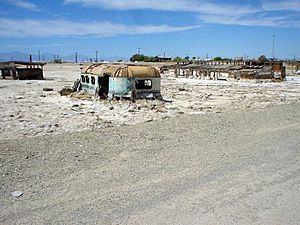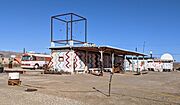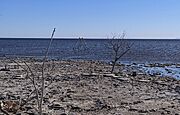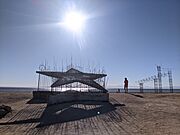Bombay Beach, California facts for kids
Quick facts for kids
Bombay Beach
|
|
|---|---|

Sign for Bombay Beach
|
|
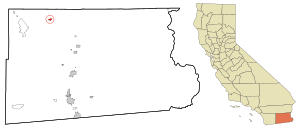
Location in Imperial County and the state of California
|
|
| Country | United States |
| State | California |
| County | Imperial |
| Area | |
| • Total | 0.66 sq mi (1.72 km2) |
| • Land | 0.66 sq mi (1.72 km2) |
| • Water | 0.00 sq mi (0.00 km2) 0% |
| Elevation | -223 ft (−68 m) |
| Population
(2020)
|
|
| • Total | 231 |
| • Density | 347.89/sq mi (134.37/km2) |
| Time zone | UTC−8 (Pacific) |
| • Summer (DST) | UTC−7 (PDT) |
| ZIP code |
92257
|
| Area codes | 442/760 |
| FIPS code | 06-07372 |
| GNIS feature IDs | 1667823, 2407878 |
Bombay Beach is a census-designated place (CDP) in Imperial County, California, United States. It is located on the Salton Sea, 4 miles (6.4 km) west-southwest of Frink and is the lowest community in the United States, located 223 feet (68 m) below sea level. The population was 231 at the 2020 census, down from 295 in 2010, down from 366 in 2000. It is part of the El Centro, California, metropolitan statistical area.
Bombay Beach was once a popular getaway for beachgoers until the 1980s, when the draining and increasing salinity of the Salton Sea destroyed the lake's ecosystem and drove businesses and private landowners out of the area, rendering Bombay Beach a ghost town. Despite this, by 2018, a number of people had moved into the area, and the town's many abandoned structures and features from its past have drawn visitors back in. A 2018 article in The Guardian stated that it was "enjoying a rebirth of sorts with an influx of artists, intellectuals and hipsters who have turned it into a bohemian playground." The Bombay Beach Biennale, an annual art festival, is held here.
History
During the 1950s, Bombay Beach was a popular beach-going destination. Celebrities such as Frank Sinatra, the Beach Boys, and Bing Crosby frequented the luxury resorts along the Salton Sea, which was known for its fishing, boating and water skiing. The area attracted half a million tourists annually, rivaling Yosemite National Park.
Bombay Beach's decline began in the 1970s, when the runoff (full of salty chemicals) led to a warning that the salinity of the lake would no longer sustain wildlife; that occurred by the early 1980s. Many residents around the Salton Sea, including those in Bombay Beach, were eventually driven out by the odor of the dying fish, the fear of health problems, and the flooding and the draining of the Salton Sea. Many of the remaining residents are reportedly either too poor to move out or too attached to the history of the area to leave. A report by the Pacific Institute in September 2019 stated that ten years earlier, "there were some 100 million fish in the Sea. Now, more than 97 percent of those fish are gone."
Most of the few residents use golf carts to get around, since the nearest gas station is 20 miles (32 km) away in Niland. There are two stores in the town, one of which is a convenience store, and the closest hospital is over 45 minutes away in Brawley. The Ski Inn bar and restaurant is the only eating and drinking establishment in the town. The "Bombay Beach Drive-In" is an art installation consisting of old, abandoned cars at a drive-in theater. A visitor in 2019 wrote that there were many "discarded homes and trailers long-since abandoned" and that many of the buildings were "windowless husks blanketed in graffiti, surrounded by broken furniture and rubble."
The derelict "living ghost town" status of Bombay Beach has attracted many photographers, filmmakers, urban explorers, and tourists. The town, as well as others on the shores of the Salton Sea, is one of the lowest settlements in elevation in North America. The local American Legion, Post 801, had 36 members in 2016 and closed down "for a few years" before reopening as a volunteer-run facility.
In 2018, as people began to move back into Bombay Beach, house prices had risen; some bungalows were selling for "tens of thousands of dollars." The community has held the Bombay Beach Biennale each spring since 2016, inviting "artists, academics, writers, and film-makers to create work, give lectures, and stage happenings". The 2020 Biennale was postponed due to the COVID-19 pandemic.
The population of Bombay Beach has been described as "mostly elderly residents" who "live in a grid of mobile homes and eccentric (and, sometimes, elaborate) small homes and shacks."
Geography
Bombay Beach is located in Southern California's Sonoran Desert. Bombay Beach is located on the east shore of the Salton Sea and, like many communities along its shores, has had to contend with fluctuating water levels, reducing size of the lake and increasing salinity. A berm was built in the 1970s to protect the west end of the town, but a portion of the town beyond the berm was either submerged or half-buried in mud.
Bombay Beach marks the southern end of the San Andreas Fault, where the southern terminus of the San Andreas transitions into the Brawley Seismic Zone.
Art
Bombay Beach features a large number of art pieces and installations around the town and along the beach.
Demographics
| Historical population | |||
|---|---|---|---|
| Census | Pop. | %± | |
| 1990 | 929 | — | |
| 2000 | 366 | −60.6% | |
| 2010 | 295 | −19.4% | |
| 2020 | 231 | −21.7% | |
| U.S. Decennial Census 1850–1870 1880-1890 1900 1910 1920 1930 1940 1950 1960 1970 1980 1990 2000 2010 |
|||
2010
At the 2010 census Bombay Beach had a population of 295. The population density was 313.5 inhabitants per square mile (121.0/km2). The racial makeup of Bombay Beach was 223 (76%) White, 37 (13%) African American, 8 (3%) Native American, 1 (0%) Asian, 0 (0%) Pacific Islander, 22 (8%) from other races, and 4 (1%) from two or more races. Hispanic or Latino of any race were 59 people (20%).
The entirety of the population lived in households, no one lived in non-institutionalized group quarters and no one was institutionalized.
There were 175 households, 19 (11%) had children under the age of 18 living in them, 51 (29%) were married couples living together, 13 (7%) had a female householder with no husband present, 4 (2%) had a male householder with no wife present. There were 7 (4%) unmarried partnerships, and 1 (1%) same-sex married couples or partnerships. 97 households (55%) were one person and 51 (29%) had someone living alone who was 65 or older. The average household size was 1.69. There were 68 families (39% of households); the average family size was 2.54.
The age distribution was 30 people (10%) under the age of 18, 16 people (5%) aged 18 to 24, 36 people (12%) aged 25 to 44, 98 people (33%) aged 45 to 64, and 115 people (39%) who were 65 or older. The median age was 58.5 years. For every 100 females, there were 113.8 males. For every 100 females age 18 and over, there were 108.6 males.
There were 449 housing units at an average density of 477.1 per square mile (184.2/km2), of which 175 were occupied, of which 115 (66%) were owner-occupied, and 60 (34%) were occupied by renters. The homeowner vacancy rate was 15%; the rental vacancy rate was 16%. 198 people (67% of the population) lived in owner-occupied housing units and 97 people (33%) lived in rental housing units.
2000
At the 2000 census there were 366 people, 178 households, and 93 families in the CDP. The population density was 363.8 inhabitants per square mile (140.5/km2). There were 440 housing units at an average density of 437.4 per square mile (168.9/km2). The racial makeup of the CDP was 71% White, 19% Black or African American, 1% Native American, 0% Asian, 4% from other races, and 5% from two or more races. 19% of the population were Hispanic or Latino of any race. Of the 178 households 18% had children under the age of 18 living with them, 39% were married couples living together, 11% had a female householder with no husband present, and 47% were non-families. 40% of households were one person and 26% were one person aged 65 or older. The average household size was 2 and the average family size was 2.8.
The age distribution was 18% under the age of 18, 3% from 18 to 24, 20% from 25 to 44, 26% from 45 to 64, and 33% 65 or older. The median age was 53 years. For every 100 females, there were 92.6 males. For every 100 females age 18 and over, there were 99.3 males.
The median household income was $17,708 and the median family income was $19,511. Males had a median income of $31,250 versus $14,213 for females. The per capita income for the CDP was $10,535. About 12% of families and 28% of the population were below the poverty line, including 40% of those under age 18 and 14% of those age 65 or over.
See also
 In Spanish: Bombay Beach para niños
In Spanish: Bombay Beach para niños



